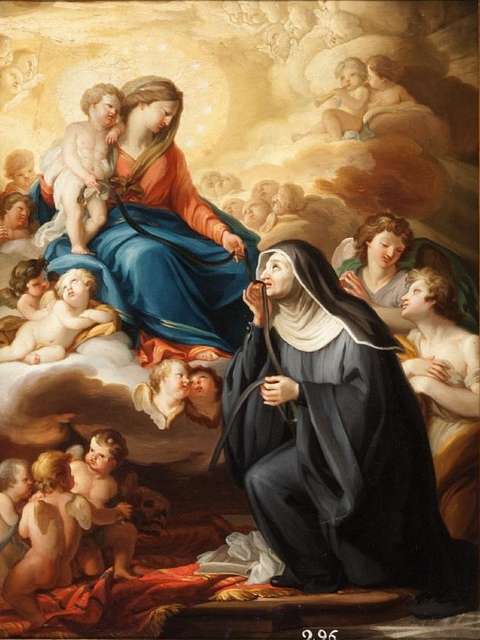Whoever is a wife and mother knows that she can never stop being one. Today you do the washing machine, send some reports, answer twenty e-mails, pick up the kids from school, have a coffee with your friends, get some highlights, and you are still a mother and a wife. St. Monica, paradigm of the family vocation in the Catholic Church, probably did something very similar to us but in her 4th century version.
In the year 332 Monica of Hippo was born in Algeria. She is known for being the mother of the brilliant (and somewhat problematic) intellectual, St. Augustine. Her untiring love and dedication to the men in her home, which caused her so many headaches, have made her the paradigm of the Catholic wife and mother. Patient, kind, humble, generous, honest, honest, honest... St. Monica lived in fullness that which St. Paul sing about the charity.
Monica of Hippo grew up in a Catholic family and her education was at the hands of a maid who shared the faith of the household. While still very young she married a member of the senate of her city, Patricius. This decurion was older than her and had vices that clashed head-on with those of his wife: he was given to drink, libertine and violent temperament.
Praying for the family
Monica patiently resisted all her husband's faults. She knew she had been cheated on and endured the angry outbursts, but she was not an impassive angel. She also needed to breathe, to take some distance. You know that coffee with friends that brings you back to life after a week of math homework with your toddler? The saint would have her equivalent. Tagaste was a city full of commerce and culture, so it's not hard to imagine Monica strolling through its streets, amusing herself talking to a neighbor, browsing the stalls, maybe petting the donkey loaded with merchandise, or sitting in a pew in the church, where she went every day to pray for her husband, who is in a great mood today....
We know from St. Augustine that his mother spent much time praying for the members of her family. Every tear was offered to God and her prayers were answered. Patrick was converted at the end of his life, died shortly after embracing Christianity and Monica decided not to remarry. It was time to devote herself completely to her children.
Soft smell of Christ
The offspring of the marriage were not baptized. The father refused to do so when they were born, so the little ones grew up without receiving the sacrament. Monica, however, made sure to do what all mothers do: a gesture, a phrase, a look... The Tagaste home was, to be sure, impregnated with the gentle scent of Christ. It was a delicate fragrance, but the saint spread it throughout the rooms of the home, waiting for someone to take a hint.
The famous Augustine was not the only son of Monica to whom she dedicated these motherly gestures. Three of her descendants survived childhood: a boy named Navigius, a girl whose name is unknown, and the bishop of Hippo. Little is known of the saint's siblings compared to him, who left his own biography in the "Confessions".
St. Augustine, the prodigal son
Agustín says of himself that he wasted his life being lazy. His intelligence and charisma opened the doors to a world of lack of control and sensuality, which he later condemned in his work. Outside the family home he maintained a stable relationship with a woman and at the age of seventeen he had a son, Adeodato.
Santa Monica knew her son's lifestyle and suffered for him. Augustine managed to unsettle his mother, who threw him out of the house when the young man returned obsessed with some Manichaeism and other things about young people that no one understands. But the banishment did not last long. Apparently the saint received in a vision encouragement to reconcile with her son. Monica opened the doors again for Augustine to return and continued to pray with the conviction that "the son of so many tears will not be lost".
The mother's patience would be tested again not much later. The son escaped to Rome and Monica, with that maternal instinct that follows children to the end of the world, traveled after him. With disappointment she realized that she was late, for Augustine left for Milan before the saint arrived. The pain caused by this cat and mouse game was alleviated by an essential event in the young man's life: in Milan he met Bishop Ambrose, a key figure in his conversion to Christianity.
The last years of Saint Monica
When St. Augustine embraced the religion of his mother, a time of peace came into the life of St. Monica. Adeodatus, Augustine and Monica lived together in what is now Lombardy. The little boy was baptized, but died two years later, when he was not yet twenty years old.
By then, St. Monica's spirit was calling for a return home to the African continent. Her dedication and prayer were bearing fruit that she was beginning to see, it was time to rest. However, she never set foot on her home again. God called Monica in Ostia, Italy. Her death inspired Augustine to write the most beautiful pages of the "Confessions", and to leave proof of his mother's legacy: a woman who lived her vocation as wife and mother to the full, who welcomed trials and consolations.
After her death, St. Monica began to be held up as an example for Christian women. Her life consisted of lovingly carrying the 4th century equivalent of our washing machines, our chauffeur-driven walks between soccer practices and birthdays, the silence before the snort of teenagers and the caress to the husband sulking because Real Madrid does not score a goal. Wife and mother, like yesterday, like today, like always.








